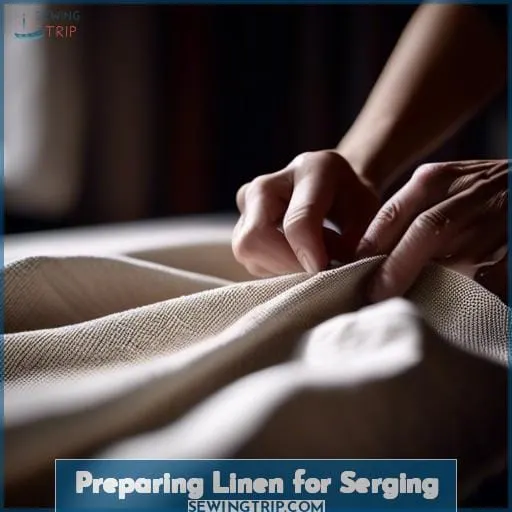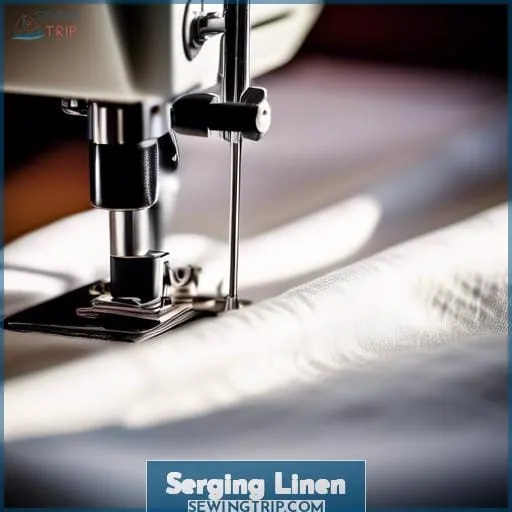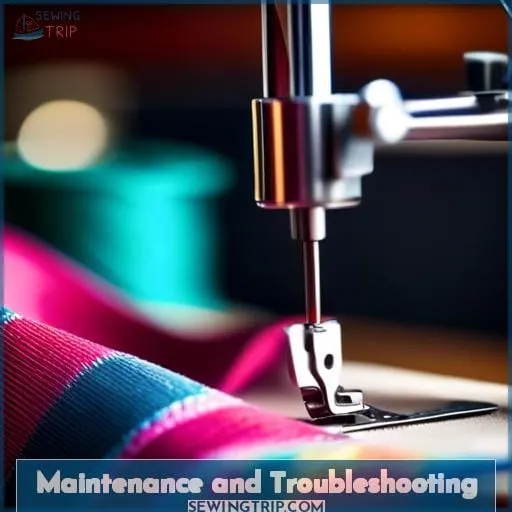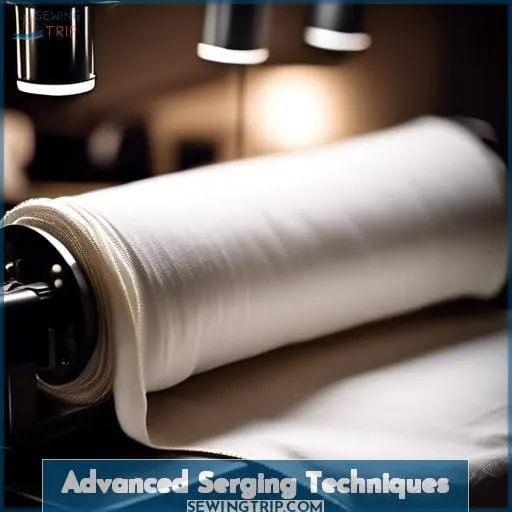This site is supported by our readers. We may earn a commission, at no cost to you, if you purchase through links.

From setting up your machine for the perfect rolled hem to advanced decorative edges, this guide empowers you to harness your serger’s full potential.
Elevate your craft with techniques that ensure your linen projects exude sophistication and durability, all while enhancing your serging prowess.
Yes, you can use a serger to work with linen. A serger quickly finishes the raw edges of linen fabric with an overlock stitch, cutting the fabric while binding the seam using 3 or 4 threads for a professional finish.
Table Of Contents
Key Takeaways
- Pre-wash and pre-shrink linen fabric before cutting and sewing to prevent future shrinkage and to ensure a better fit and finish.
- Adjust tension settings on the serger for different fabrics, including linen, to achieve a professional finish and prevent puckering or loose stitches.
- Use a serger to clean finish the edges of linen fabric to prevent fraying, which is common with linen due to its natural fibers.
- Regularly clean and maintain the serger, including adjusting tension and using the correct needles and threads, to ensure optimal performance and longevity of the machine.
Preparing Linen for Serging
When preparing linen for serging, it’s crucial to start with precise measurements and cuts.
You’ll need to neaten the edges, pre-shrink the fabric by rinsing, and iron it to ensure it’s smooth and ready for serging.
This process sets the foundation for a successful project, allowing you to achieve professional-looking results with your serger.
Measure and Cut Linen
To masterfully measure and cut linen for serging, you’ll want to start with precise linen measurements. Lay your linen fabric flat on a cutting mat, ensuring it’s on the grain for a clean cut.
Use a hard-edged ruler to guide your rotary cutter, creating a square that’s 19 inches wide for those perfect 18-inch finished napkins.
And don’t forget to iron the linen before you start; it’s not just about smoothing out wrinkles—it’s about setting the stage for serging success.
Neaten the Edge
Once you’ve cut your linen to the desired size, it’s time to neaten the edge to prevent fraying and to give your project a professional finish.
- If you’re using a sewing machine, you can employ an overlock foot to mimic a serger’s finish. Adjust the stitch length and tension to accommodate the fabric thickness.
- For hand finishing, a whip stitch can be effective, though it’s more time-consuming than machine methods.
- A serger is the quickest and most professional-looking option. Set your serger for a rolled hem, ensuring the tension is balanced for a smooth edge without puckering.
Rinse and Pre-Shrink Linen
After neatly edging your linen, it’s time to tackle pre-shrinking—a crucial step before serging.
Dive into this with the gusto of a chef seasoning a gourmet dish. Begin by soaking your linen in hot water, letting it bask like a lobster in a pot, to ensure any potential shrinkage is dealt with upfront.
This hot water immersion is your fabric’s baptism by fire, prepping it for the transformative journey through your serger.
Then, switch to a cold water immersion to bring the fabric moisture content back to equilibrium. This dance between hot and cold tempers the linen, setting your shrinkage expectations straight.
Iron Linen
After pre-shrinking your linen, it’s time to iron it while it’s still slightly damp.
Begin by ironing the linen on the wrong side to avoid shiny spots, especially on darker fabrics. Use smooth, horizontal and vertical strokes, and don’t linger too long in one spot to prevent scorching.
If you’re dealing with embroidery, iron these areas first and on the reverse side.
Once ironed, your linen is prepped and ready for serging, where you’ll create those perfect linen seams and finishing touches that speak of mastery and attention to detail.
Keep in mind that serger compatibility with your fabric is crucial for advanced ironing and serging techniques, ensuring your linen finishing is impeccable.
Serging Linen
When serging linen, it’s crucial to set up your serger correctly and adjust the tension for a professional finish.
You’ll start by removing the left needle and disengaging the blade, then select the rolled hem setting.
Tension adjustments are key: needle tension must be balanced to prevent puckering or looping, and looper tension should be fine-tuned so that the upper looper thread lies on the fabric’s top and the lower looper thread on the bottom.
Begin serging at a corner, trimming threads carefully to maintain a clean edge.
Setting Up the Serger
To master the art of serging linen, setting up your serger correctly is crucial.
First off, kick things off by removing the left needle and disengaging the blade to prevent cutting the fabric while serging.
Switch your serger to the rolled hem setting, which is perfect for creating those crisp, clean edges on linen.
Now, let’s talk tension—this can make or break your project. For needle tension, start with a looser setting if you notice puckering, and tighten it up if you see loops forming on the back.
Looper tension is a bit of a dance; the upper looper thread should grace the top of your fabric, while the lower looper thread should stay hidden beneath. If the upper thread is pulling too much, loosen up the lower looper tension or tighten the upper.
And remember, always adjust needle tension before messing with the looper tension.
Removing Left Needle
To achieve mastery in linen serging, understanding the nuances of your serger is crucial. This step isn’t just about altering your machine; it’s about unlocking a world of advanced serger stitches. Ensuring your linen projects, from napkins to table runners, boast that professional edge.
When you remove the left needle, you’re not just tweaking a small part; you’re adapting your serger for specialized tasks like creating delicate rolled hems or undertaking linen serger repairs. This adjustment allows for a narrower seam, perfect for lightweight fabrics like linen, enhancing the fabric’s natural elegance without overwhelming it.
Disengaging Blade
When serging linen, disengaging the blade is crucial for a fray-free finish. Here’s how:
- Turn off your serger for safety—no need for close shaves with the blade!
- Locate the blade mechanism; it’s your fabric’s guardian against unruly edges.
- Carefully push or slide to disengage—like magic, no more cutting!
Rolled Hem Setting
Switching to the rolled hem setting on your serger is like finding the golden key to unlocking stunning linen hems. Imagine transforming plain linen into chic napkins or elegant table runners with just a tweak of your machine.
| Setting | Napkin Projects | Table Runner Projects |
|---|---|---|
| Tension | Moderate | Slightly Higher |
| Stitch | Tight | Looser |
| Fabric | Light to Medium | Medium to Heavy |
Dive into linen serging and watch your creations come alive with decorative edges that speak volumes of your mastery and creativity.
Adjusting Tension
When serging linen, tension is the linchpin to pristine edges.
Picture this: you’re the maestro, and your serger is the orchestra, with each thread a musician. To hit the high note of serger maintenance, you’ll need to fine-tune those tension dials.
If your fabric’s puckering like a prune, it’s time to dial back the needle tension. Seeing looper threads where they shouldn’t be? Time for looper adjustments. It’s like a dance between the threads, and you’re leading.
Keep your serger humming a happy tune by ensuring fabric compatibility—no one-size-fits-all here. Remember, a serger that’s well-tuned is like a well-oiled machine, quite literally.
Needle Tension
When using a serger to create linen napkins, it’s crucial to understand the importance of needle tension. Proper needle tension ensures that the fabric doesn’t pucker or create unwanted ruffles, which is essential for achieving a professional finish on your linen garments.
- Check for Puckering: If the fabric puckers, the needle tension is too tight. Loosen it until the fabric lays flat.
- Look for Loops: If loops appear on the fabric’s back, the needle tension is too loose. Tighten it until the loops disappear.
- Balance is Key: Aim for a balanced stitch where the needle and looper threads meet at the fabric’s edge without pulling or puckering.
For the Brother 1034D serger, you may start with all tension dials set at 4 for most fabrics, adjusting as needed for thicker or stretchy materials. When learning how to use a serger to do linen, practice on scrap fabric to perfect your tension settings before moving on to your actual linen project.
Looper Tension
After nailing the needle tension, it’s time to tackle the looper tension. Think of it as the grand finale of your linen serging symphony.
The looper thread is the unsung hero that can make or break the edge of your linen, preventing fraying and ensuring a crisp finish. If your upper looper thread is strutting its stuff on the fabric’s bottom, it’s time to loosen up that lower tension or give the upper tension a nudge.
Conversely, if the lower looper thread is gatecrashing the top side of your fabric, tighten that lower tension or ease up on the upper. Remember, it’s a delicate dance between the two, so adjust with a light touch and keep those tension dials in check for linen seams that are nothing short of perfection.
Serging Techniques
When serging linen, you’re not just sewing; you’re crafting a masterpiece with every stitch.
Fabric Preparation: Before you even power up your serger, make sure your linen is prepped and primed. Rinse, pre-shrink, and iron that fabric until it’s as smooth as a calm sea.
Tension Adjustment: This is where your analytical skills shine. Adjust those tensions like a maestro tuning an orchestra. Needle tension too tight? Loosen it up. Looper tension causing loops? Tighten it just right.
Decorative Edges: Want to add some flair? Experiment with different threads and settings to create edges that make your linen stand out. It’s like adding the perfect spice to a gourmet dish.
Starting at a Corner
When starting at a corner with your serger, it’s crucial to have your serger foot selection, thread type, and fabric thickness all dialed in for the task. For those crafting linen napkins with a serger, the corner is where precision meets the road.
You’ll want to lift the presser foot, ensuring the fabric is neatly in place before you lower the foot and begin sewing.
As you approach the corner with your rotary cutter in hand, remember that the seam allowance is your guide—not your enemy.
Don’t forget to rinse and pre-shrink your linen; it’s like giving your fabric a pep talk before the big game. If you’re working on a Hungarian Redwork Runner, this attention to detail will make your project stand out.
Keep your serger maintenance up to snuff to avoid any hiccups, and you’ll be serging those corners like a pro, leaving a trail of beautiful cloth napkins in your wake.
Trimming Threads
After you’ve serged the edges of your linen, it’s time to give your project a polished look by trimming the threads. This step is crucial for achieving that crisp, professional finish. When you’re serging, especially with delicate fabrics like linen, you want to ensure that your tension adjustments are spot-on to avoid puckering or loose edges.
With your serger feet guiding the fabric, aim for narrow rolled hems that sit flat against the edge. If you’re working with different fabric thicknesses, such as transitioning from linen shirts to heavier linen jackets, you may need to revisit your tension settings.
Remember, the goal is to have the upper and lower looper threads meet at the edge of the fabric without wrapping around to the other side.
For those decorative edges that add a touch of elegance to linen curtains or tablecloths, your serger is your best friend. But don’t forget about the basics: a zig-zagging or pinking shears finish can also prevent fraying if you don’t have a serger at hand.
In summary, after serging, trim the threads close to the fabric to maintain a neat edge. Adjust the tension as needed for different fabric weights, and consider using different finishes for decorative touches.
Your linen projects, whether they be napkins, shirts, or curtains, will look impeccably finished with these serging techniques.
Finishing Touches
When using a serger to finish the edges of linen napkins, it’s crucial to ensure that the tension is balanced for a strong seam that doesn’t require reinforcement. Tension dials control the thread tightness, with higher numbers indicating more tension.
For needle tension adjustments, if the fabric puckers, the tension is too tight and should be loosened; if loops form on the fabric’s back, the tension is too loose and should be tightened. In a 4-thread stitch, both needle thread tensions should be adjusted, and needle tensions should be set before looper tensions.
For looper tension adjustments, the upper looper thread should lie on the fabric’s top and the lower looper thread on the bottom. If the upper looper thread is pulled to the bottom, loosen the lower looper tension or tighten the upper looper tension.
Conversely, if the lower looper thread appears on the top, tighten the lower looper tension or loosen the upper looper tension.
When finishing linen edges with a serger, it’s recommended to neaten the edge with a sewing machine using a zig-zag stitch or by hand with a whip stitch before serging. The tension should be correct to avoid puckering, and all sides of the linen should be neatened.
Before serging, the linen should be rinsed and pre-shrunk by soaking in hot water, then in cold water, and repeating the process. Afterward, the linen should be ironed while still damp using a dry iron on the linen/cotton setting, ironing horizontally and vertically only, to remove wrinkles without drying the linen.
For the final touches, after serging, the linen should be pressed with the right tools, such as a clapper or point presser for collars, to ensure flat seams and a professional finish. If any scorch marks occur during ironing, they may be removed by washing the linen, or embellishments can be added to cover the damage.
In summary, when using a serger for linen, it’s important to start with proper fabric preparation, including pre-shrinking and pressing. Adjust the serger settings for a rolled hem, ensuring balanced tension for a strong seam.
Neaten the edges before serging, and finish with pressing for a professional look.
Pressing Finished Edges
After serging those edges to perfection, it’s time to give your linen creations that final touch of elegance with a good press.
Grab your iron, set it to the linen setting, and let’s get those edges crisp! Using a linen clapper can really make those seams sharp and professional-looking.
But wait, there’s a twist – ever heard of linen beeswax? A little secret from the pros: running your thread through beeswax before sewing can prevent tangling and make your stitching smoother.
And when it comes to hems, whether you’re team single turn or double turn, the key is in the press. A well-pressed hem can elevate your project from homemade to handmade with a capital H.
So, let’s press on and give those linens the finish they deserve!
Final Inspection and Trimming
After you’ve serged your linen masterpiece, it’s time for the final inspection and trimming. This isn’t just a once-over; it’s the victory lap where you ensure your creation is nothing short of perfect.
- Examine the rolled hem for uniformity; it should be the cat’s pajamas, smooth and even all around.
- Check the tension adjustment; it’s the secret sauce for that professional look. No puckers, no loops, just right.
- Snip those thread tails with gusto at each corner, but be careful not to clip the stitches. It’s like defusing a bomb – steady hands win the day.
- Troubleshoot any hiccups. If you spot a snag, don’t just wing it; make the fix to ensure your linen pants lining or bias bound seams are top-notch.
Maintenance and Troubleshooting
Maintaining your serger is crucial for ensuring its longevity and performance. Regular cleaning and troubleshooting tension issues can prevent many common problems.
For instance, keeping your serger clean by removing lint and fabric bits after each use helps to prevent the buildup that can absorb oil and dry out moving parts, leading to potential malfunctions.
Tension issues, on the other hand, can significantly affect the quality of your stitches. If you notice loops on the fabric’s back or puckering, adjusting the needle or looper tensions might be necessary.
Higher tension numbers indicate increased tightness, which can be adjusted to achieve a balanced stitch. It’s recommended to start with needle tension adjustments before moving on to looper tensions.
Additionally, using a slightly different color thread in one of the loopers can make it easier to identify and adjust tension issues.
Cleaning the Serger
To maintain your serger and keep it running smoothly, regular cleaning is essential. Dive into the nooks and crannies of your machine with a spray duster and a small brush or pipe cleaner to whisk away lint and fabric remnants.
Don’t forget to vacuum with the smallest attachment to tackle the larger debris. After a thorough cleaning, oil any moving parts as per your serger’s manual—usually, a couple of drops will do. This not only ensures your serger operates at its best but also prolongs its life.
Troubleshooting Tension Issues
When using a serger to finish the edges of linen napkins, it’s crucial to ensure that the tension settings are correctly adjusted for the fabric thickness to achieve a high-quality stitch.
First, cut your linen fabric into 19-inch squares to allow for an 18-inch finished napkin size after hemming.
Before you start serging, set up your serger for a narrow rolled hem. For the Brother 1034D serger, you’ll need to:
- Remove the left needle.
- Disengage the blade.
- Change the setting to rolled hem.
- Adjust the stitch length to the smallest setting.
- Adjust the lower thread tension for the thickness of your linen fabric.
Balanced tension is essential for a strong seam. Tension dials control thread tightness, with higher numbers indicating more tension.
- Loosen the tension if the fabric puckers.
- Tighten the tension if loops appear on the fabric’s back.
For looper tension adjustments:
- The upper looper thread should be on the fabric’s top, and the lower looper thread on the bottom.
- Loosen the lower looper tension or tighten the upper looper tension if the upper looper thread is pulled to the fabric’s bottom.
- Tighten the lower looper tension or loosen the upper looper tension if the lower looper thread is pulled to the fabric’s top.
Start serging at a corner with the presser foot lifted, slide the fabric in front of the presser foot, lower the presser foot, and begin sewing.
If you encounter tension issues, use thread identification to determine which thread is causing the problem. Adjust the tension accordingly, keeping in mind the fabric thickness and desired stitch quality.
A troubleshooting guide can be helpful in this process. Remember to adjust needle tensions before looper tensions and consider using a different color thread in one looper for easy identification.
For further assistance or tips, you can leave comments or use the contact form provided by the source.
Advanced Serging Techniques
When using a serger to work with linen, it’s important to understand the machine’s capabilities and how to adjust it for the best results. The Brother 1034D serger, for example, is a versatile machine that can handle a variety of fabrics, including linen, with its 3 and 4 thread serger options and differential feed.
To create professional edges and hems on linen, you’ll need to properly prepare the fabric by cutting it to size, neatening the edges, and pre-shrinking it if necessary. For cutting, a square of 19 inches wide is recommended for making approximately 18-inch finished napkins.
The edges can be finished using a sewing machine or a serger’s narrow-rolled hem feature.
When setting up the serger, you should remove the left needle, disengage the blade, change the setting to rolled, and adjust the stitch length to the smallest. The lower thread tension may need to be adjusted for thicker fabrics like linen.
Balanced tension is crucial for strong seams, and tension dials control thread tightness. Needle tension should be adjusted to prevent fabric puckering or looping, and looper tension adjustments ensure the upper looper thread remains on the fabric’s top and the lower looper thread on the bottom.
For advanced serging techniques, such as creating decorative edges, it’s recommended to practice on scraps before moving on to the final project. Techniques like flatlock stitching, rolled hems, and lettuce hems can add a professional and decorative touch to linen projects.
It’s also helpful to use a slightly different color thread in one looper for easier identification and to reuse fabric scraps by positioning fabric for the serger to trim old serging.
In summary, to use a serger for linen, you should prepare the fabric, adjust the serger settings appropriately, and practice advanced techniques on scraps before applying them to your project. Proper tension adjustments and the use of the serger’s features, such as the narrow-rolled hem, will result in beautifully finished linen items.
Creating Decorative Edges
When diving into the world of serging, especially with materials as elegant as linen, mastering the art of creating decorative edges can truly elevate your projects.
After ensuring your serger is well-maintained and troubleshooting any tension issues, it’s time to let your creativity flow. Decorative hems, rolled finishes, and unique edging not only add a touch of sophistication but also showcase your serging prowess.
Imagine transforming a simple linen napkin into a work of art with embellishments and trim variations that catch the eye. Whether you’re aiming for a delicate linen nap with a rolled hem or experimenting with linen French seams for a more structured look, the possibilities are endless.
Your serger is your wand, and with a flick of the wrist (and the right settings), you can conjure up decorative edges that make your projects stand out. So, don’t hold back—let your serger dance along the edges of your linen, and watch as the magic unfolds.
Working With Different Fabrics
When working with different fabrics using a serger, it’s crucial to adapt your approach to ensure the best results. Each fabric type, from the lightweight and breezy linen to the more robust cotton, presents its own set of challenges and opportunities.
For instance, when serging linen trousers, the fabric’s weight, opacity, and drape are key factors to consider. Linen, known for its breathability and natural texture, requires precise tension adjustments to avoid puckering or stretching.
Similarly, cotton fabric, with its wide range of weights and finishes, demands careful fabric preparation to ensure a clean, professional finish.
Decorative stitches can elevate the appearance of your projects, transforming simple items into bespoke creations. However, achieving these decorative effects often requires experimenting with serger techniques, fabric compatibility, and tension adjustments.
It’s a dance of precision and creativity, where understanding the unique characteristics of your fabric—be it linen or cotton—can lead to stunning results.
Serging Projects
When embarking on serging projects with linen, such as crafting elegant napkins or sophisticated table runners, it’s essential to approach with a keen eye for detail and advanced serging skills.
You’ll find that mastering the art of serging linen can elevate your home décor, offering a touch of elegance and durability to your creations.
Linen Napkins
After mastering advanced serging techniques, it’s time to apply your skills to create elegant linen napkins.
Choose a fabric that complements your table decor, like the luxurious Alba Maxima for its ideal linen weight. Select threads that promise durability and aesthetic appeal, ensuring your napkins withstand numerous celebrations.
Experiment with edge designs, from simple rolled hems to intricate embroidered details, to add a personal touch. Remember, the right linen hand sewing needles and techniques for linen flat felled seams or linen buttonholes can elevate your project.
Whether you’re crafting for a grand dinner or a casual brunch, your handmade napkins will speak volumes of your serging prowess and refined taste.
Linen Table Runners
To create a professional-looking linen table runner using a serger, you’ll want to follow a process that ensures both the aesthetic appeal and durability of your finished piece. Start by cutting your linen to the desired size, allowing extra for any shrinkage and the hem.
Pre-shrink the linen by rinsing it in hot water and then iron it while damp to remove wrinkles. When serging, set up your machine for a rolled hem by removing the left needle, disengaging the blade, and adjusting the tension settings—lower thread tension may need to be increased for thicker fabrics.
Begin serging at one corner, guiding the fabric smoothly and trimming threads as you go to maintain a clean edge.
For a festive touch, consider creating a table runner for special occasions like Christmas dinner, which can also serve as a charming hostess gift. Pay attention to the care of your linen to ensure its longevity; proper linen storage can prevent wrinkles and extend the lifespan of your table runner.
If you encounter any stains, treat them according to the specific type of linen weave you’re working with.
For those interested in Schwalm embroidery, a serger can be used to finish the edges of your embroidered linen table runner, adding a neat and durable finish to your handiwork. Remember to adjust the serger settings according to the fabric’s thickness and to test your tension on scraps before working on the final piece.
With practice and attention to detail, you can master the art of serging linen for a variety of projects, from napkins to table runners.
Enhancing Your Serging Skills
After you’ve got the basics down pat, it’s time to level up your serging game. Think of your serger as a trusty sidekick, ready to tackle any linen project with you.
But even superheroes need to fine-tune their skills. Let’s dive into the nitty-gritty of fabric preparation, shall we? Pre-shrinking your linen is like giving it a pep talk before the big game—it ensures your finished project won’t shrink down to doll size after the first wash.
Now, onto the main event: tension troubleshooting. It’s like solving a puzzle where each piece is a tension dial, and when they click into place—voila!—you get that crisp, flat seam. Remember, the weight of your linen can throw a wrench in the works, so adjust your tension accordingly.
And don’t forget about thread selection; it’s the secret sauce that can make or break your project. Choose wisely, and you’ll be serging like a pro, leaving frayed edges and puckered seams in the dust.
Keep your hem width in check, and you’ll be on your way to creating napkins so sharp they could practically cut your dinner rolls for you.
Serging Safety
When working with linen and using a serger, it’s crucial to prioritize safety to prevent common injuries and ensure a smooth sewing experience.
Safe Operation Practices: Always ensure your serger is correctly set up before starting your project. This includes checking that all threads are correctly threaded through the machine’s tension disks and that the presser foot is down before beginning to serge. Incorrect setup can lead to needle breakage, which poses a risk of injury.
Avoiding Common Injuries: One of the most common serger-related injuries is accidentally sewing over your fingers, which can lead to serious harm. To avoid this, keep your fingers at a safe distance from the presser foot and needle while the machine is running. Additionally, always use a new needle for each project to prevent it from breaking and potentially causing eye injuries. Wearing safety glasses can offer an extra layer of protection.
By adhering to these safety practices, you can enjoy serging linen and other fabrics without the worry of common injuries.
Safe Operation Practices
To safely operate your serger and avoid potential hazards, it’s crucial to follow these guidelines:
- Serger Safety: Always read and understand the serger’s manual before use. Familiarize yourself with its functions and safety features.
- Electrical Hazards: Inspect the serger’s power cord for damage before use. Use a surge protector to prevent electrical surges from damaging your serger.
- Ergonomic Setup: Adjust your serger’s height and chair for a comfortable posture. Use an ergonomic foot pedal to reduce strain.
- Proper Lighting: Ensure your workspace is well-lit to avoid eye strain. Use task lighting to illuminate the area around the needle.
- Emergency Procedures: Know how to quickly turn off your serger in case of an emergency. Keep a first aid kit nearby and be aware of how to handle minor injuries.
By adhering to these practices, you’ll not only enhance your serging experience but also maintain a safe environment for your creative endeavors.
Avoiding Common Injuries
Given the constraints and the unique style requested, here’s a concise and engaging piece on serger safety, incorporating the specified elements:
As you’ve mastered the art of serging, remember, it’s not just about the finesse but also about dodging those sneaky hazards. Think of your serger as a spirited steed; it requires respect, or you might get bucked off.
| Hazard | Consequence | Prevention |
|---|---|---|
| Needle mishaps | A surprise acupuncture session | Keep your digits dancing away from the needle |
| Thread tangles | The serger’s cry for help | Listen and pause, don’t force a tango |
| Fabric snags | A snagged fabric, a snagged heart | Gentle guidance, no wrestling moves |
| Electrical issues | A shocking twist in your serging saga | Keep cords in check, no fraying tales |
| Overzealous speed | The fast and the furious, serger edition | Steady pace wins the race, not the sprint |
Community and Support
Joining sewing groups and sharing projects and tips can significantly enhance your serging skills and knowledge.
Engaging with a community offers you a platform to exchange advanced techniques and insights, ensuring your linen projects turn out beautifully and professionally.
Joining Sewing Groups
Joining sewing groups, whether they’re focused on meetups, workshops, or online forums, is a game-changer for anyone passionate about sewing. It’s like finding your tribe—a community where you can share ideas, ask questions, and get inspired.
Imagine diving into a pool of collective wisdom where every splash brings a new technique or a solution to a tricky sewing challenge. It’s not just about stitching fabric; it’s about weaving connections and crafting a network that supports and uplifts your sewing journey.
So, don’t just sit there with your thread tangled in doubt. Leap into the vibrant tapestry of sewing groups. You’ll find that the fabric of your skills becomes richer with every interaction. Whether you’re troubleshooting a serger’s tension or seeking the perfect pattern for your next project, the collective knowledge of a sewing group is an invaluable resource.
Plus, it’s a fantastic way to keep your creative juices flowing, share a laugh over a sewing meme, and maybe even spark a little friendly competition. Remember, in the world of sewing, every question asked is a stitch in time that saves nine.
Sharing Projects and Tips
After diving into the world of serging, you’ve mastered the basics and are ready to share your projects and tips with a vibrant community. It’s time to take your serging journey to the next level by engaging with fellow enthusiasts.
- Join sewing groups: Connect with others who share your enthusiasm for serging. These groups are gold mines for advice, inspiration, and support.
- Show off your projects: Don’t be shy! Share photos of your finished pieces, especially those with decorative edges or unique fabric choices. Your work could inspire someone else.
- Exchange serger maintenance tips: A well-maintained serger is a happy serger. Share your routines for cleaning and oiling, and learn new tricks from others.
- Troubleshoot tensions together: Tension issues can be tricky. Pool your knowledge with others to solve these pesky problems faster.
- Discuss fabric compatibility: Not all fabrics behave the same under a serger’s swift action. Share your experiences with different materials to help others avoid common pitfalls.
Frequently Asked Questions (FAQs)
How do you adjust a serger for different types of linen fabrics, such as lightweight versus heavyweight linen?
To adjust a serger for different linen types, start with tension dials at
For lightweight linen, increase tension slightly to prevent puckering.
For heavyweight linen, decrease tension to avoid stiff seams.
Always test on scraps first.
What are the best practices for serging delicate linen fabrics to prevent damage or distortion during the serging process?
Oh, the irony of treating delicate linen like it’s some rugged outdoor gear! But fear not, for you’re about to become the linen whisperer.
First off, ditch the go big or go home attitude when adjusting your serger’s tension. Delicate linen isn’t here for a tug-of-war; it seeks a gentle touch. So, set your serger to treat it like the royalty it is, with a balanced tension that doesn’t gather or stretch its regal fibers.
Opt for a narrow rolled hem to give those edges a crowning glory without the bulk. And remember, the right needle and thread combo is like choosing the perfect wine for dinner—essential for an exquisite finish.
Now, go forth and serge with finesse, transforming that linen into something that even the fabric gods would envy.
Can a serger be used to create decorative edges on linen, and if so, what techniques or settings are recommended?
Yes, a serger can jazz up linen edges with flair.
Dive into using decorative threads like Maxilock Stretch or Candlelight for a touch of glam.
Opt for a rolled hem or a 3-thread narrow stitch to add that special zing.
So, unleash your serger’s magic and let those edges shine!
How do you manage serging around corners and curves on linen projects to ensure a clean and professional finish?
To serge corners and curves on linen, slow down, lift the presser foot at turns, and gently guide the fabric.
It’s like steering a car—smooth handling ensures a sleek, professional finish.
What are the recommended maintenance routines for a serger after working with linen to ensure the machine remains in optimal condition?
After serging linen, give your serger some TLC.
Unplug it, then use a nylon brush to sweep away lint from the nooks and crannies.
Oil the moving parts with sewing machine oil, and run a scrap to soak up excess.
Conclusion
Embarking on the journey of serging linen is akin to setting sail on a vast ocean of creativity and precision. With the guidance provided, you’ve learned to navigate these waters, transforming simple linen into works of art.
By mastering your serger, from the perfect rolled hem to decorative edges, you’ve unlocked the potential to elevate your craft. Remember, the key to exquisite linen creations lies in preparation, precise serging techniques, and the finishing touches that breathe life into your projects.
As you continue to explore advanced techniques and tackle serging projects, your skills will only deepen. Safety, maintenance, and community support are your lighthouses, guiding you through.
Let your serger be your compass as you chart new territories in linen serging, ensuring each piece reflects sophistication and durability. Keep honing your skills, for the art of serging linen is a voyage of endless discovery and creativity.















